

A place to share YOUR boat building story
Glen-L Marine Designs - 9152 Rosecrans Ave. - Bellflower, CA 90706
 In this issue
In this issue
-
Feedback: Console Skiff by Larry
Bourne
-
Feedback: Imp by Shane Smith
-
From the Archives: Afloat at last
-
My Epoxy Won't Cure by ArtDeco
-
Photos sent in since the last WebLetter
-
Inflation?
-
Calendar: September 2006
-
Shop Talk: Bass Boat notes by George
Robertson
-
From the Boatbuilder Connection
-
Recent email
GLEN-L Update
- Friday, 4 August, Allyn left Glen-L for the last time, on his way to Colorado in a caravan of two moving trucks, a car, pickup truck and a trailer with two motorcycles. We've had two calls from him... all is well in Colorado.
- We have approximately 200 Frame Kits in stock, but supply is limited. When these are gone, we will not make more. All plans and patterns and other kits are still available. I have talked to several builders who have plans and patterns and are considering a Frame Kit. They were surprised when I told them that they may not be available. If you are interested in a Frame Kit, check our online catalog. If one is listed for the boat you are interested in, it is available. When the last one is sold it will be removed from the shopping cart.
- Thanks to ArtDeco, Larry Bourne, Shane Smith, George Robertson and all the others who contributed to this WebLetter. The success of this WebLetter depends on builders like you. Share your experiences with your fellow builders; there is a place in the next WebLetter for your project.
Editor
Feedback: Console Skiff
by Larry Bourne
I emailed you some time ago regarding the Console Skiff that I’d purchased. It was built by Don Bernard of Newport Beach in, I think, 2000. Although I was unable to contact Mr. Bernard, I appreciated your assistance then, and thought you might like an update on my experiences with the boat over the past 1½ years..
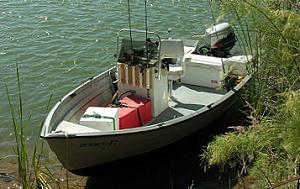
The boat has performed well, and finally, a few weeks ago, I got caught out in rough water while on vacation in Johnstone Strait, B.C., Canada while looking for (and finding) Orcas, or Killer Whales. The area has many small islands scattered over many miles, and after several hours of playing around and exploring between, and in the shelter of, the islands, I re-emerged into Johnstone Strait to find that the wind had become extremely strong and gusty, and I had a really sloppy, bumpy 10 mile ride back to Telegraph Cove.
The only problem was from wind blowing spray over the windward side of the boat, which my two 1000 gph bilge pumps took care of with no problem. Even with foul weather gear it got uncomfortable tho’, and I finally zig-zagged back to port to minimize the spray. It worked very well, the boat worked very well, and at no time did I feel that I was in any danger. The boat is very solid, very dry, and did not pound at all, even in 3 – 5 ft short period chop. Even going at a low planing speed of about 15 – 16 mph, the boat hit with a solid thump, not a tooth cracking bang like many boats. I was very impressed and came back with a grin on my face.
I have gone as much as 30 miles off-shore at Puertocitos, Mexico with this boat, 10 miles down Chilko Lake, B.C., 50 miles up Dworshak Reservoir in Idaho, and 40 miles up the Colorado River from Cottonwood Cove to Hoover Dam. It has been in the ocean off Bella Coola, B.C.,as well as Neah Bay and Port Angeles, WA. It’s a great design, and I plan on hanging on to it. Re-finishing is under way.
Larry Bourne
Palm Springs, CA.
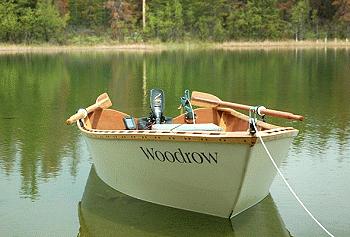
Feedback: IMP
by Shane Smith
It has taken some time, but I have finally collected some decent photos of 'Woodrow', my rendition of the 10' Imp. I pondered several designs, looking for a stable, flat-bottomed ten footer, to be used for a portable fly fishing boat, on the small freshwater lakes of British Columbia's interior. I wanted a boat that could be used with either a gas motor, an electric motor, or simply rowed, and it had to be light enough that I could get it on and off my utility trailer, or into the back of the pickup.
I have now used Woodrow for just over a year, and I have been very satisfied with this little boat. It has proven itself to be an ideal platform for fly fishing, and carrying the scads of gear that I find myself lugging along on those trips. Although it works very well with my Honda 5 horse motor, I think it is at its best with an electric motor, and it rows very nicely. I am 6'5", 210 pounds, and I seldom wish for a more stable boat -- I can stand up and cast from the center seat, with no difficulty. Although it is certainly no featherweight, I am able to load it into my truck, but it is an easier task with a helper.
The boat is constructed with 6mm Mahogany marine ply, sandwiched between kevlar cloth and epoxy. Gunwales are of steam-bent White Ash, and mahogany, with a couple chunks of Belizean Teak for oarlocks. The interior frames are of Douglas-fir, and the battens are Spruce.
I made several modifications to the original Glen-L design. I modified the sheer lines somewhat to suit my own tastes, giving the boat some more height than was called for. I changed around the seating configuration, so that the interior of the boat is very open and comfortable for fly fishing. I added a couple of removable, plywood/carpet floors, to make handling fly lines easy, and to add comfort. I added bow and stern anchor sockets, to facilitate double-anchoring for fly fishing. Lastly, I added kevlar tape to the outside seams of the boat, to make it as durable as possible for sliding up on rocky shorelines (I'd use fiberglass next time).
You may have noticed that Woodrow changed colours in it's short year of life. I initially used some marginal hardware-store marine paint to do the hull, and opted to re-paint with different paint, when I noticed that the colour of the green paint had washed out, below the waterline when the boat was in use for a day or more. After painting Woodrow with the new paint, he got some fancy new decals.
This is a great fly fishing boat, and I wouldn't hesitate to recommend it to anyone with similar needs. I have enclosed several photos of the boat, for you to post on the Glen-L site.
Smooth sailing!
Prince George, British Columbia
From the Archives: Afloat at last
The following is a story about the construction of the Yukon by Stephan and Roz Skochinsky.
A year ago Stephen and Roz Skochinsky were hard at work on their boat in the backyard of their home...
|
Continuing with the theme of real-life experiences, I thought this subject might be appropriate as boat-building activity is picking up. My Epoxy Won't Cure
The dreaded cry rings out in the night
He thought he could put them on at once
It may have been the temperature
Or it may have been the wrong proportion
Then again, it may never get cured
Best not to dwell on what went wrong
Spread it onto those fillets and joints
Mix only the amount you can quickly use
-ArtDeco |
Photos sent in since the last WebLetter... |
Inflation?
The following is a letter from Foster Sparkman builder of the Argosy featured in WebLetter 67. It was written earlier this year, but was "filed" for use in a WebLetter, then forgotten.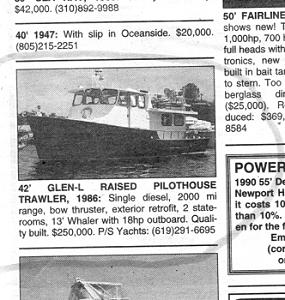
Saugus, CA
2-20-06
Glen L
This 42' Trawler cost me $23,000 to build in 1986, with a Ford 135 HP Diesel. It is for sale for $250,000. (See the attached page from "The Log" Feb. 10th 2006.)
Foster Sparkman
Calendar: September 2006
30th Annual Wooden Boat Festival
Port Townsend, WA
September 8 - 10, 2006
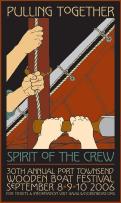
Join us this year!
The Port Townsend Wooden Boat Festival has a history, location, spirit, quality of boats and people that make it the most talked about wooden boat festival in the world, "the woodstock of wooden boats". You don't have to own a boat to experience the inspiration or meet the people for which this festival is famous.
www.woodenboat.org/festival/index.htm
2nd Annual New England
Amateur Boatbuilders Messabout
Little Neck Beach in Ipswich, MA.
Saturday, Sept. 9 from 10:00 am to whenever
There is a public launch in Ipswich, then a 1-2 mile run up the Ipswich river to Little Neck Beach, which is the northernmost tip of Crane's beach. Interested people can contact me at 978-685-2755 or marcb@aline.com.
...Marc E Bourassa
21 Muskoka Gentleman’s Racer Wooden Boats
Muskoka Wharf, Gravenhurst, Ontario
Saturday, Sept. 9-10, 11:00am to 3:30pm
I am trying to put together a video event
on Saturday September 9th, 2006 and Sunday September 10th, 2006 at the
newly open Muskoka Boat and Heritage Center located at the Muskoka Wharf
in Gravenhurst Ontario from 11:00am to 3:30pm. The event is to showcase
21 Muskoka Gentleman’s Racer Wooden boats as well as interesting
cars and custom Harley bikes. I would like to invite you and owners of
antique, classic and Rod & Custom cars & boats to join us in
Gravenhurst. Could you please forward my poster and details in an email
that you send out to your site members. It will go a long way in
promoting this video and I think people will have a really good time. The
owners of these wooden boats will admire the cars and the car owners will
likely enjoy the boats as well as the beautiful setting on the Southern
Tip of Lake Muskoka in Gravenhurst. We are filming this event and being
the weekend after Labour Day, the traffic should be light and the journey
enjoyable. And the weather is usually GREAT! This will be a great event
for all those attending, boats & bikes and cars... what a weekend!!
If you know of anyone I should include, please forward my email and
contact info. I really hope you will attend, and share my event with some
enthusiasts.
Neil
PS Below is a picture of what I spent the past 2 years creating; a
Gentleman's Racer Wooden Boat (Cracker Box) that was featured at the Toronto
International Boat Show, as well as in print and on television. More than
a few  attendees called it a Ferrari on water. The entire boat is
custom made from the exhaust tips to the bow hook to the steering and
shift mechanisms. 283 chevy small block bored 30 over, racing roller cam,
aluminum racing manifold and 4 brl carb. Looks nice too and she goes!
attendees called it a Ferrari on water. The entire boat is
custom made from the exhaust tips to the bow hook to the steering and
shift mechanisms. 283 chevy small block bored 30 over, racing roller cam,
aluminum racing manifold and 4 brl carb. Looks nice too and she goes!
Dragon Boat Festivals in September
Shop Talk: Bass Boat notes
by George Robertson
Hi, Barry: Thanks for your input regarding the chine/bowpiece joint (Bassboat) we spoke of on the phone. I'm attaching a photo of what I did. I hope it's what it should look like. It appears it will work well with the planking.
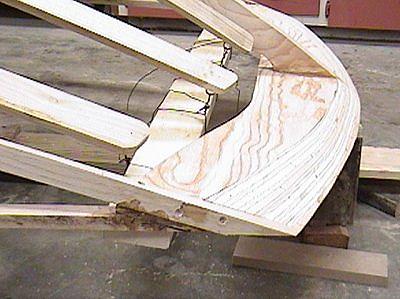
Thanks, also for your recommendation to "be generous" with the pilot holes for the screws in white oak. I attached/glued the battens yesterday and actually used my pilot drill/countersink bit for #12 screws rather than #10 and they hold well without binding or breaking. I was nervous about drilling into the battens at frame 4 since there's so much stress on the battens at that point but it went well without breaking the battens. I had steamed/formed them several times and tapered the contact area in the frame. I'm getting close to putting the side and bottom planking on after some joint fairing/cleanup.
I've rough cut the 1/4" pw side panels and 3/8" pw butt block pieces. Is it recommended to join the two 8' pieces into one 16' long piece prior to attaching or attach one 8' piece at a time? I've considered putting the butt block on the end of one piece and then attaching that to the boat, then fitting the second piece but I'm not sure if there are hidden pitfalls. What is your recommendation. The same question applies to the bottom planking. I think it would be easier to fit the butt blocks between the battens after the bottom is on but, again, I'm not sure of unforeseen pitfalls/problems.
Thanks for your advice
George Robertson
From the Boatbuilder Connection
Post subject: TOTAL COST EXCLUDING ENGINE
Graham Knight
Joined: 13 Nov 2003
Posts: 1254
Location: Shepperton, England
Posted: 04 Jul 2006 03:00 pm
Post subject: Glen-L doesn't do complete kits for these boats, only
frame kits and they are being discontinued. If keeping the cost down is
important, then making your own frames will help a lot.
We've found time and again that pricing a build can be very
difficult if not impossible, it all depends on where you live, what
material is available and the prices in your area. Also how resourceful
you are in acquiring your materials, you can save a huge amount by
recycling used timber which can often be had for free, and how you finish
your boat will make a difference too.
As Steve said fibreglassing is not essential, but it cuts down on
maintenance work and cost later on, and the boat will probably last
longer, and it actually doesn't cost that much to do anyway. Glassing
accounted for about 10% of the cost of my Squirt, and reduced the amount
of paint and primer that would otherwise have been required to achieve a
similar finish.
Tubby Tug, ready and legal
Tag lines...
For what it's worth, I hope my last words are, "Damn, that was stupid." ...Cec
I think its okay we get carried away, but I ain't gonna carry you back.. ...canibul
Isn't it amazing!! The person that never has the fortitude to pursue his own dreams, will be the first to try and discourage you from pursuing yours. ...Dave Grason
If you're dedicated long enough, they'll let you be committed! ...Brian Eager
One day. ...John Bowen
I'm losing my short term memory, and also my short term memory. ...Smith Brother
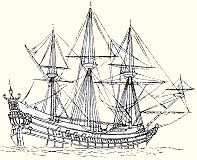
Recent email:
On Fri, 11 Aug 2006, Eric Stramecky wrote:
Re. Riviera power (Chevy small-block)
Barry:
I am not familiar with the horsepower ratings for these engines. What horsepower were the boats designed for?
Eric
ANS:
Barry
With the Chevy small-block, these boats are running in the 50-55 mph range. Although larger engines could be used, the boat really isn't meant to go much faster. Small-blocks will vary considerably in HP, but 185 HP would be common. Cubic inches run from 283 to 400. Because the Chevy small-block has been around for so long with no changes to the bolt patterns, it is the most readily available in this country and there are more conversion parts available for it. It is our "default" engine.
Subject: help with motor size please
Date: Monday, August 07, 2006
I ordered the Class AB Plans & Patterns this morning. On the website it is recommended to use a 10hp motor but I want to know what size I can put on it as a maximum?
ANS: The maximum HP varies with use. As a racing boat, the boat was limited by the cubic inch requirements of the class, you can have as much HP as you could get out of the engine. As a pleasure boat, the maximum HP is based on a "US Boating and Safety Act" formula that takes dimensions from the boat. Based on this, 10 HP is the maximum.
See: http://www.glen-l.com/weblettr/webletters-5/webletter43.html#uscg
Weight is an important issue. One builder put a 50 HP motor on the TNT. He had two friends who held up the transom when he got in to keep it from swamping. We would consider this too much HP. The problem with any small boat is that at some point as speed increases, there will be very little of the boat in the water; it tends to "float". If something happens at these speeds, you could loose control.
When mentioning speeds of 60+ mph, how much hp did those engines have?
ANS: I don't know.
Thanks
Jeff
Subject: Popular Mechanics "Cover Girl" Swish
Sent: Sunday, August 06, 2006 9:35 PM
Hi,
I noticed an ad in a woodworking mag for your web site. Since I had built one of your boats, I decided to look at the web site. I was surprised to see that you are offering plans for the Swish.
In 1958 I was a subscriber to Popular Mechanics. I read the article on the Swish and decided "why not?" I scaled the drawings up to full sized patterns and built it. I didn't like the "fins", even though I was a Mopar fan, so I modified the plans accordingly. The finished product had a mahogany deck and was fibreglassed all over, including clear finish on the deck. My family was very proud of our boat. We initially had a new 35 HP Evinrude. Subsequently, we moved up to a 75 Evinrude. The boat handled the bigger engine beautifully. We had a little trouble with slip in the turns initially, so I added a deeper full length keel.
I was in my 20's when I built the boat. We had 3 boys, and did a lot of water skiing on the San Joaquin/Sacramento Delta. We ran the boat for eleven years before graduating to fiberglass. I am now in my seventy's and retired after a great career with DuPont doing electrical and process control engineering work.
My family and I would like to express deep gratitude for the chance to build something that was very meaningful in our young lives, something we probably could not have otherwise afforded.
Thank you,
Glenn Wristen
Gualala, CA 95445
Below is the result of your feedback form. It was submitted on Saturday,
July 15, 2006 at 18:18:10
--------------------------------------------------------------------
firstname: Kerry
lastname: Church
Comments: Hi Guys, What lovely trad boats these are, I just love them. I
am looking at buying a 22ft riviera off a guy here in N.Z. She is powered
by a 350 chev and has a top speed of around 50 to 55 mph. Will send some
photos when I get her.
Kind Regards
Kerry Church
Below is the result of your feedback form. It was submitted on Thursday,
July 13, 2006 at 02:37:54
-------------------------------------------------------------------
firstname: Archie
lastname: Clark
Subject: Boat Photo Archives
From: John Miseresky
Date: Wed, 5 Jul 2006
I just recently was very pleasantly surprised to discover your wonderful website and glad to see that Glen L is still going strong. I had built a Glen L boat about 35 years ago, as a father-son project with my father (now deceased) and I still have the boat and all the great memories that went along with it. The boat was the 15 ft "Swish" which has been maintained in great shape, and still runs great with the 85 HP Merc on the back. I also noticed your section on Builder Photos which included some great shots of the Swish, and I would like to ask if you accept new additions to the archives. I would be proud to add our Swish to your archives, if possible. I could at your convenience, forward some digital photos and a brief background similar to your published format. I think that you would agree that this is another great example of your now classic design, complete with the tail fins, and it would be a nice tribute to see it on your website. I would appreciate if you would please let me know, and thanks again for your great design. Thanks, John
On Fri, 30 Jun 2006 08:15:45 -0700 (PDT), Ammon Diether wrote:
Gayle,
Feedback on the telesiminar: - The tips where great. Things like
Zolatone, Aluminum being appropriate for the gussets, and calibrating
your mixing cups with water. Information about what Glen-L does when
building is very interesting to me. - The instruction on building frames
was OK. I think I can sum it up real easily. Follow the instructions.
It's not rocket science. - The assurances were very good.
"Building the frames is one of the easier parts of building a
boat." I am sure this helped a lot of people feel much more
confident on building the frames. I came out feeling that I can do it. -
The sense of community is worth noting. The Boatbuilding Connection sees
this too. You feel a part of something. The call had that feeling. -
Probably should include the date at the beginning or end of the seminar.
- The guy at the end who was about to launch a boat was a great way to
end. - A little too much confusion when you opened it up for questions on
who gets to talk and when and about what subject. Some questions I have
on building frames:
- On the frames for larger boats, approximately how heavy/large can
those frame members get to? Any special considerations when building and
positioning large frames?
ANS:
There are no definite answers to these questions. These are design questions. The designer will determine material size and frame spacing based on the construction method. In some cases (V-Gull) partial bulkheads are made with very few full frames. The Hunky Dory has a lot of frames, the Sweet Caroline does not. The CS20 S&G design has none. There are various ways to stiffen a hull, this is where the designer comes in.
- What is the priority of correctness of a frame? Symmetry, quality of the glue joint, quality of the fastening, etc? Or another way to ask it, is there a certain aspect when building frames that is absolutely essential, like "The frames must be symmetrical"?
ANS:
Frames must be accurate and symmetrical, but if it falls apart, accuracy is a moot point. We never assume that a glue joint will be perfect, so we generally leave fasteners in, but if you are using a thickened epoxy and have good contact, fasteners are redundant.
- Alan mentioned when he started he was an apprentice. What were some of the tips/rules passed on to him from whoever trained him? Were there some that he eventually ended up disagreeing with?
ANS:
I doubt that Allyn can remember back that far. Before Allyn, the frame kits were made by Don Ruffa. He is the guy with black curly hair in "Boatbuilding with Plywood" and the "Build it the Glen-L Way" manual. After a bad accident (on a home project), Don retired. Louie came in. He was an experienced woodworker, used to working in a large shop, supervising other employees. Allyn came to work for Louie. Louie taught Allyn the procedures of production and the use of the larger woodworking machinery. After a relatively short time, Louie decided that the work was more physical than he wanted and left the shop to Allyn. The thing that makes Allyn special, is that he can quickly figure how to do things. Louie probably gave Allyn a lot better grounding than Don would have and in fact the quality of the frame kits improved after Louie, then Allyn took over. The thing that Allyn brought to the job was a personal concern about making the best product he could.
Build more boats
GLEN-L boats, of course


















